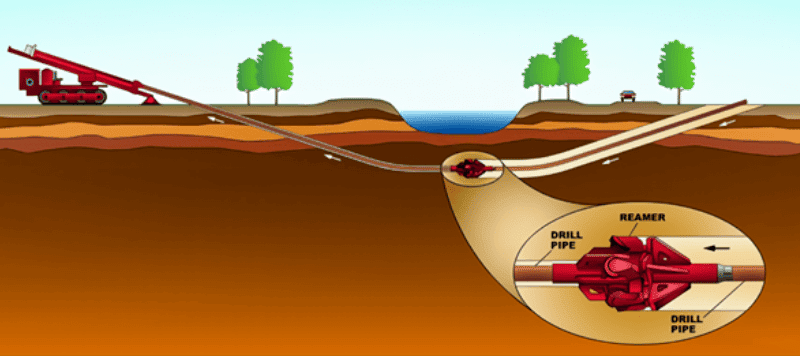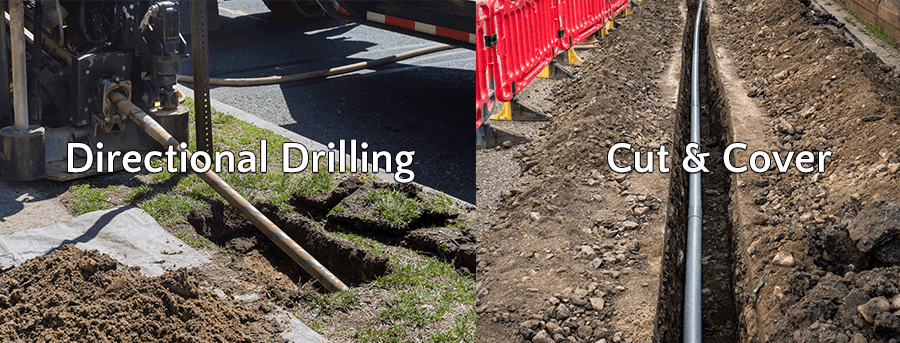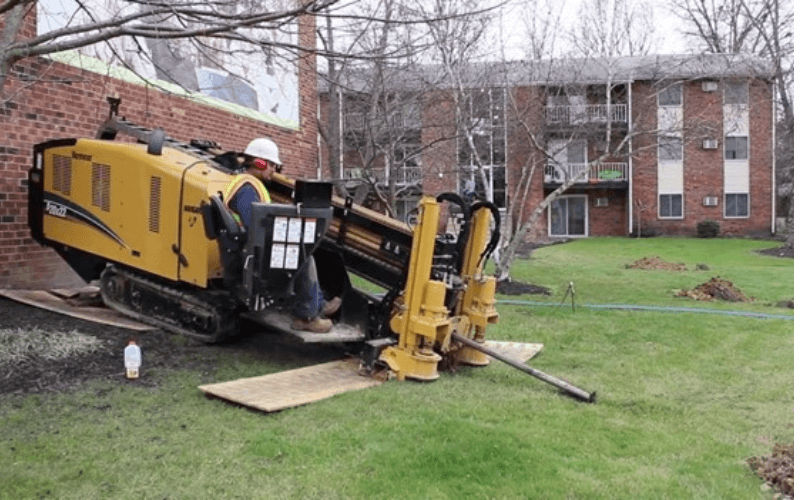Directional drilling, sometimes also referred to as horizontal directional drilling (HDD), is the practice of drilling non-vertical bores along a prescribed underground path. It requires the use of specialized (directional) drilling equipment and the mud rotary drilling technique is often employed for larger scale directional drilling projects.

Additionally, directional drilling is a trenchless and steerable method of installing underground utilities such as pipe, conduit, or cables in a relatively shallow arc or radius along a prescribed underground path using a surface-launched drilling rig. The actual path of the borehole is monitored during the drilling process by taking periodic readings using wire, a magnetic field, and/or radio waves to determine the inclination (degrees from horizontal) and azimuth (degrees from magnetic north) of the leading edge or advancing drill bit.
Brief History of Directional Drilling
Directional drilling was initially developed in the 1930s by the petroleum industry to aid in accessing oil and gas reservoirs. Several major advances occurred in the 1970s (such as the mud motor) and use of directional drilling greatly expanded in the 1990s, driven largely by fiber optic installations and the need to install horizontal wells or piping for environmental monitoring or remediation purposes.
Directional drilling today can be used to install piping of up to 60-inches in diameter for distances of over 10,000 feet. Directional drilling is currently employed in over 50% of all underground utility installation work.
Directional Drilling vs. Traditional Cut and Cover
Directional drilling offers significant advantages over traditional cut and cover pipeline/utility installations. The technique is routinely used when conventional trenching or excavating is not practical due to the presence of obstacles such as buildings, roadways or streams, or when minimal surface disturbance is required. Because most of the ground surface remains undisturbed during directional drilling, the impact to the surrounding environment, both natural and manmade, is drastically reduced.

When Things go Wrong – Drilling Claims and Accidents
Directional drilling is a technically complex process; when things go wrong or mishaps occur, many parties can be impacted, and the damage can be catastrophic.
- Roads can collapse
- Water or sewer lines can rupture
- Environmental damage can occur (including groundwater impacts by “fugitive” drilling fluids)
- Power lines can be severed, resulting in widespread electrical outages
Insurance claims and legal actions often ensue in such cases and, given the increasing use of directional drilling, these are occurring more frequently. Analysts handling such insurance claims may find a need for technical assistance in reviewing the information submitted and understanding the cause and origin of the loss. When assessing the cause and who is at fault, finding a forensic engineer or consultant familiar with directional drilling is advisable.
First, it must be determined if the directional drilling contractor followed all the correct methods and proper procedures, that their equipment was adequately maintained, and that the requisite safety protocols were in use. A challenge with horizontal drilling is that if there is a problem, it usually occurs underground. The contractor must rely on the accuracy of the plans they have been provided with and the results of subsurface utility markouts (calling 811) and ground penetrating radar surveys that may have been performed. Specific regulatory requirements, responsibilities, and protocols for subsurface drilling and markout activities may vary state by state and identification of such requirements, and whether or not they were adhered to, may also be necessary.
Thus, when accidents do occur, the paperwork trail can be substantial. Which government entity has ownership? Which utility companies were involved? Who hired the contractors? What plans were they using? Were the plans followed? Were the plans correct? Who did or did not update the plans? An experienced forensic engineer or consultant can be invaluable in determining the responsibilities of the involved parties and understanding the myriad of contractor/subcontractor relationships that exist, especially when government entities are involved.

HOW CAN VERTEX HELP?
With experience assisting insurance carriers with directional drilling claims and an extensive staff of environmental professionals and engineers, VERTEX can assist in the review the technical evaluation of insurance claims involving directional drilling. VERTEX can review the available information and facts to assess who was at fault and responsible for the incident and our engineers and forensic accounting staff can also assess the reasonableness of the claimed loss and submitted damages, including losses relating to business interruption and lost revenue.
To learn more about VERTEX’s Environmental Consulting services or to speak with an Environmental Expert, call 888.298.5162 or submit an inquiry.




